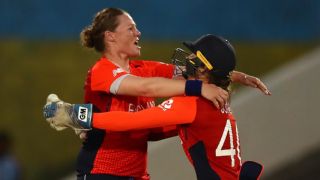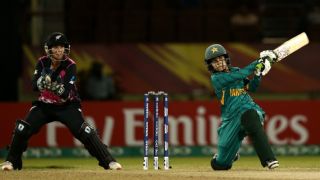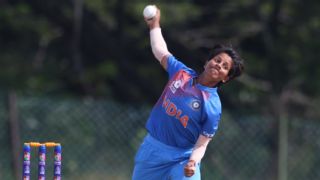|
After three weeks and a rather one-sided final that capped off the first-ever standalone Women's World T20, ESPNcricinfo's Melinda Farrell, Annesha Ghosh and Shashank Kishore picked our team of the tournament. The biggest debate centred on who should be the wicketkeeper. Having gone back and forth between Amy Jones and Alyssa Healy, it was decided Healy would have the gloves, her off day in the final notwithstanding. Ashleigh Gardner's all-round show in the final was key to her inclusion, while Harmanpreet Kaur was decided on as captain, having made a greater impact on the tournament as a whole than Javeria Khan - the other international captain in the XI - did.  1. Alyssa Healy - 225 runs, average 56.25, strike-rate 144.23 Five games, four Player of the Match Awards and the tournament's MVP. Alyssa Healy and husband Mitchell Starc are the only cricket couple so far to have two World Cup Player of the Tournament trophies in their cabinets at home. Healy comfortably finished as the highest run-scorer despite playing one innings fewer than the next best, Harmanpreet Kaur. Her mere presence in the Australian line-up gives opponents the fear that no target is beyond their reach. No surprises that the only game she didn't bat in - because of a concussion scare - was the one Australia lost. 2. Smriti Mandhana - 178 runs, average 35.6, strike-rate 125.35 At this World T20, Smriti Mandhana's form ran in reverse to her run in 2017 World Cup. In that tournament, she started off with 90 and 102 and although they set the tone for India's breakout campaign, she herself couldn't muster any more big scores. A year later, on the slow and low tracks of the Caribbean, Mandhana scored only 2 and 26 in her first two matches. But in the league game against Ireland, India's vice-captain showed glimpses of her free-spirited, chart-topping strokeplay from her maiden Kia Super League stint, with a 29-ball 33. That led her to a career-best 83 against Australia, followed by a quickfire 34 on a tricky pitch in the semi-final against England, but India couldn't build on her good work.  3. Deandra Dottin - 121 runs, average 24.20, strike rate 101.68; 10 wickets, average 7.7, economy rate 5.63 Big-hitter with the bat, handy seam-ups with the ball, electric at point and a crowd-puller - Deandra Dottin is quite a package to have in the XI. Earlier in her career, she batted in binary mode - six or out. Over time, she's learnt to temper her game to suit situations and allow herself time in the middle before she unleashes the big hits. The big improvement though, has been in her bowling. She has added a few yards of pace and her accuracy allows West Indies to often have an iron grip over proceedings. In the league stages, her five-wicket haul sucker punched Bangladesh, and her tight spell undid South Africa, as they lost 9 wickets for 28 runs. 4. Harmanpreet Kaur (capt) - 183 runs, average 45.75, strike-rate 160.52 The World T20 didn't just get off to a bang. There was plenty of crash and wallop mixed with finesse and class as Harmanpreet Kaur made a 51-ball 103 against New Zealand in the tournament opener. Her epochal 171 not-out was arguably the standout innings of the 2017 World Cup and her innings at Providence towered above the rest in a low-scoring tournament. Also, her contribution of 43 runs in a vital partnership with Mandhana in the victory over Australia ensured India finished their group stage undefeated.  Harmanpreet's captaincy, however, was questionable at times, and the decision to omit her most experienced batter and ODI captain, Mithali Raj, from the semi-final against England has triggered lots of debate. Still, having led India to their first World T20 semi-final since 2010, in her first world tournament as captain, the 29-year-old's value is both clear and immense. 5. Javeria Khan - 136 runs, average 45.33, strike-rate 130.76 The greatest credit to Javeria Khan's batting is her strike-rate from the World T20. She is a touch player and doesn't muscle big sixes like some of the other established strikers. But she more than makes up for it by accessing unconventional areas of the ground with her array of sweep shots. Javeria's leadership, and the faith she showed in her bowlers, was particularly refreshing. She had come into the tournament with the captaincy mantle thrust on her at the last hour, but you wouldn't have known that from the unperturbed way in which she carried herself. 6. Ashleigh Gardner - 90 runs, average 22.50, strike rate 115.38; 10 wickets, average 10.7, economy rate 5.94 With Healy doing monumental damage at the top of the order for Australia, there were limited opportunities for the 21-year-old Ashleigh Gardner to show her power game. But she saved her best all-round performance for the biggest stage, hitting an unbeaten 33 in a match-winning partnership with Meg Lanning that secured the title. Her three wickets, including top-scorers Dani Wyatt and Heather Knight, were instrumental in restricting England to just 105 and took her tally for the tournament to 10, at an average of 10.70. It was also encouraging for the sport's diversity to see an Indigenous Australian crowned Player of the Match in the final of a World Cup.  7. Ellyse Perry - 60 runs, average 60.00, strike rate 122.44; 9 wickets, average 9.88, economy 5.56 Ellyse Perry continues to be one of the best examples of how a premier allrounder offers security and flexibility to a team. Australia had an in-form top order, which meant Perry floated at Nos. 3, 6 and 7 in the tournament, remaining unbeaten in four of the five innings she played. Scant opportunities with the bat meant she could tally only 60 runs, her best returns an unbeaten 23-ball 39 in the defeat to India. That last league game - a record 100th T20I for any Australian, male or female - also handed Perry figures of 3 for 16, her best haul in the tournament. She fuelled Australia's fourth title-winning campaign with 2-1-2-2 in the semi-final against West Indies, and got a 100th T20I wicket dismissing the dangerous Natalie Sciver in the final. 8. Amy Jones - 107 runs, average 53.50, strike rate 113.82 On the evidence of her show at her first global event, Amy Jones can be a utility player in England's side even when Sarah Taylor returns to take over the wickekeeping duties. Tidy behind the stumps, solid and punchy in front of them, Jones showed spunk in the most crucial innings - the semi-final on a slow pitch against a plethora of India's spin options to make a half-century. She may have had the advantage of having played against India before, but the application and patience necessary to nullify them in conditions more Mumbai than Antigua, made that 53 not out the most important knock of her short career.  9. Anya Shrubsole - 7 wickets, average 12.57, economy rate 4.88 Despite the absence of Katherine Brunt, Anya Shrubsole wheeled away efficiently just as she has done for the better part of the last six years. She has that late inswing with the new ball, it builds pressure, scoring becomes difficult and batsmen lose their wickets looking for the big hits. It was like clockwork. The Player of the Final in last year's World Cup didn't have a haul anywhere close to the six-for she took on that fateful day at Lord's, but was still key in England's bowling plans in the Powerplay in the Caribbean. Her fitness and athleticism only augur well for England as they build towards another Ashes year. 10. Kirstie Gordon - 8 wickets, average 12.25, economy rate 5.15 Overcoming back pain from England's last group fixture, the 21-year-old left-arm spinner broke India's back in the semi-final when she took out Harmanpreet and Veda Krishnamurthy in the 16th over. Formerly a mainstay of the Scottish line-up, she played a World T20 Qualifier and a World Cup Qualifier before switching allegiances. Gordon's only unimpressive showing at this World T20 came in England's loss to Australia in the title clash. That, however, didn't take the sheen off a performance in which she finished England's highest wicket-taker in her first global tournament. It all began with a haul of 3 for 16 on debut.  11. Poonam Yadav - 8 wickets, average 15.75, economy rate 6.30
11. Poonam Yadav - 8 wickets, average 15.75, economy rate 6.30
The leading wicket-taker across men's and women's T20Is this year, leggie Poonam Yadav shepherded India's young spin contingent with aplomb on the spin-friendly Guyana surface, where India played all their group matches in daytime. Poonam took at least one wicket in each of those four matches. That included 3 for 33 against New Zealand in the opening game of the tournament, where she removed the dangerous Sophie Devine and Jess Watkin off consecutive deliveries. Such was the threat Poonam posed that in the lead-up to the semi-final, England's coaching staff are known to have sent throwdowns on their knees in the nets to mimic her low release point and loopy trajectory. It clearly worked because she went wicketless. 12th man Jahanara Alam - 6 wickets, average 10.16, economy 5.08 In the six-month lead-in to the tournament, Bangladesh's journey from clinching their maiden Asia Cup title to making it to the World T20 via the qualifying event paralleled 25-year-old allrounder Jahanara Alam's form. A former T20I captain, Jahanara hit the winning runs in the low-scoring final against India in June, and had Bangladesh's first ever T20I five-for three weeks later. In Bangladesh's tournament opener at the World T20, she inspired hopes of an upset as West Indies openers Dottin and Hayley Matthews fell off the first two balls of her opening spell. Although she missed out on the hat-trick, Jahanara's 3 for 23 and a brilliant one-handed catch off her own bowling, headlined that game as did her 3 for 21 against Sri Lanka in Bangladesh's win-less campaign.
|
